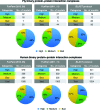An overview of comparative modelling and resources dedicated to large-scale modelling of genome sequences
- PMID: 28777078
- PMCID: PMC5571743
- DOI: 10.1107/S2059798317008920
An overview of comparative modelling and resources dedicated to large-scale modelling of genome sequences
Abstract
Computational modelling of proteins has been a major catalyst in structural biology. Bioinformatics groups have exploited the repositories of known structures to predict high-quality structural models with high efficiency at low cost. This article provides an overview of comparative modelling, reviews recent developments and describes resources dedicated to large-scale comparative modelling of genome sequences. The value of subclustering protein domain superfamilies to guide the template-selection process is investigated. Some recent cases in which structural modelling has aided experimental work to determine very large macromolecular complexes are also cited.
Keywords: comparative modelling; protein structure prediction; template selection; template-based modelling.
Figures


References
-
- Altschul, S. F., Gish, W., Miller, W., Myers, E. W. & Lipman, D. J. (1990). J. Mol. Biol. 215, 403–410. - PubMed
Publication types
MeSH terms
Substances
Grants and funding
LinkOut - more resources
Full Text Sources
Other Literature Sources

